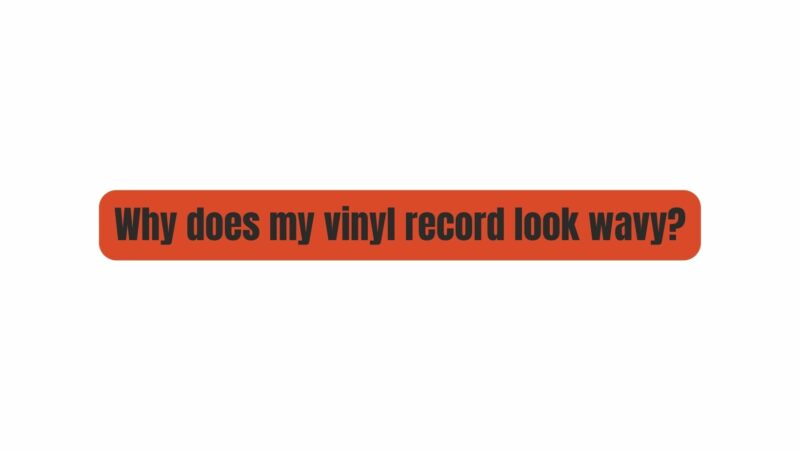The resurgence of vinyl records in recent years has rekindled the love affair with analog music, capturing the hearts of audiophiles and music enthusiasts worldwide. The tactile experience of handling vinyl records, placing the stylus gently on the groove, and savoring the warm, authentic sound is unparalleled. However, for many vinyl collectors, encountering a wavy record can be perplexing and disheartening. In this article, we’ll explore the intriguing world of wavy vinyl records, uncovering the reasons behind this phenomenon, and discovering potential solutions to restore these cherished musical artifacts to their former glory.
Understanding Wavy Vinyl Records
A wavy vinyl record refers to a disc that exhibits a noticeable waviness or unevenness in its surface. Instead of lying perfectly flat, the edges or sections of the record may curve upward or downward, creating undulating ripples along its playing surface. This distortion can impact the playback experience, causing audible issues and potential damage to the record and playback equipment.
Causes of Wavy Vinyl Records
- Manufacturing Defects: One of the primary reasons for wavy vinyl records is manufacturing defects. During the pressing process, if the vinyl material is not evenly distributed or if there are issues with the temperature and pressure, it can result in variations in thickness, leading to waviness.
- Cooling Process: Vinyl records are subjected to a cooling process after being pressed. If this cooling process is not uniform or controlled properly, it can cause the vinyl to contract unevenly, resulting in wavy records.
- Storage Conditions: Improper storage of vinyl records can contribute to waviness. Records stored horizontally or under heavy objects, which apply uneven pressure, can cause the records to warp over time.
- Environmental Factors: Extreme changes in temperature and humidity can affect the shape of vinyl records. Vinyl is sensitive to its environment, and exposure to unfavorable conditions can lead to warping and waviness.
Effects of Wavy Vinyl Records
The presence of waviness in vinyl records can lead to several adverse effects:
- Audible Distortion: The most noticeable effect is audible distortion during playback. As the stylus encounters the uneven surface, it can cause fluctuations in pitch and speed, resulting in a distorted and unpleasant listening experience.
- Stylus and Groove Damage: Continuous playback on wavy records can accelerate wear and tear on both the stylus and the grooves of the record. This can lead to permanent damage to both the record and the playback equipment.
- Tracking Issues: The stylus may struggle to maintain proper tracking on a wavy record, potentially causing the needle to skip or jump, further degrading sound quality.
Solutions for Wavy Vinyl Records
While wavy vinyl records can be disheartening, there are steps you can take to mitigate the issue and potentially restore these records to playable condition:
- Gentle Flattening: For mildly wavy records, gentle flattening may help. Place the record between two sheets of clean, heavy glass or acrylic and expose it to mild heat, such as sunlight or a heat lamp. This can gradually encourage the vinyl to regain its original shape. Be cautious not to overheat or apply excessive pressure.
- Professional Restoration: Severe cases of wavy records may require professional restoration. Experienced vinyl record specialists can apply controlled heat and pressure to correct the waviness. However, this is a delicate process and should only be undertaken by experts.
- Preventive Measures: The best approach is prevention. Proper storage in a cool, dry, and vertical position is crucial. Invest in purpose-built record storage solutions and avoid stacking records horizontally or placing heavy objects on them.
- Quality Control: When purchasing vinyl records, inspect them for any visible warping or waviness before adding them to your collection. High-quality pressings from reputable manufacturers are less likely to exhibit manufacturing defects.
Conclusion
Wavy vinyl records may pose a challenge to vinyl enthusiasts, but with a deeper understanding of the causes and potential solutions, collectors can better preserve and enjoy their cherished collections. While prevention through proper storage and quality control is the most effective approach, mild waviness can often be gently corrected with care and patience. Ultimately, the magic of vinyl records lies in their ability to transport us to the heart of the music, and by addressing waviness, we ensure that this timeless experience remains as enjoyable as ever. Whether you’re a seasoned collector or new to the world of vinyl, the journey of exploring and caring for your vinyl records is an enduring and rewarding one.


